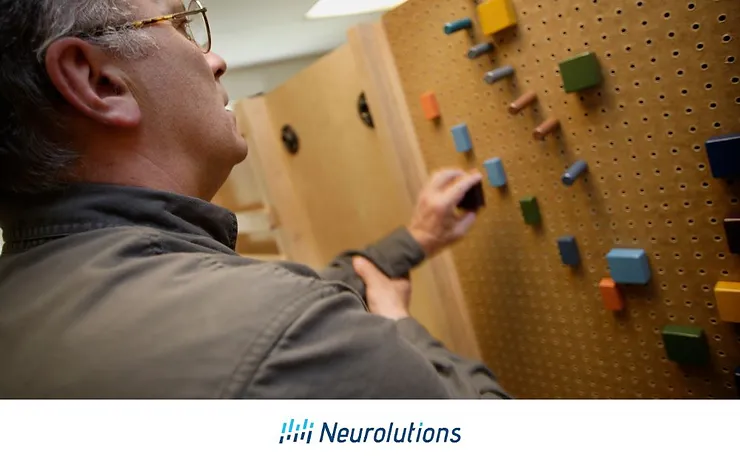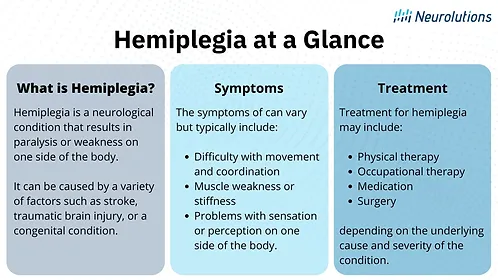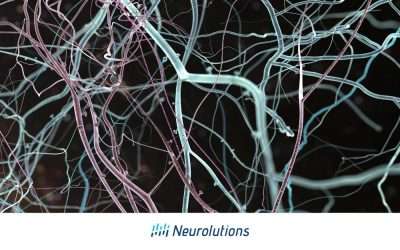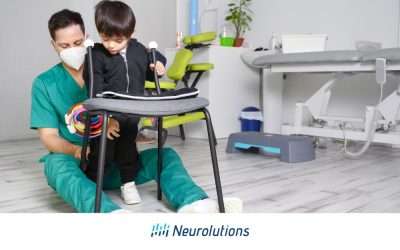In the event of a stroke, you may experience severe or complete loss of motor function on one side of the body, known as hemiplegia (1) The side of the body in which you experience hemiplegia may depend on the location of the stroke.
The classic dogma is that if a stroke occurs on the left hemisphere of the brain, it will affect the right side of the body. Therefore, the individual will experience right-side hemiplegia. In contrast, if the injury within the brain occurs on the right hemisphere of the brain, the left arm and leg is likely to be affected.
Knowing the location of where the stroke occurred and the severity of the stroke occurred better understanding you, your therapists, doctors, and other medical professionals have to map out the best recovery plan and interventions.
The different topics that will be discussed in this article include explanations, symptoms, diagnosis, and treatment of hemiplegia, as well as how to manage hemiplegia.
What is Hemiplegia?
“Hemi” refers to half while “plegia” refers to paralysis. Hemiplegia is a symptom that involves one-sided paralysis. Paralysis refers to loss of control or movement of the muscles in the affected part of the body.
As mentioned earlier, it can either occur on the right or left side of the body, depending on the type of stroke. Hemiplegia can be temporary or permanent, relating to the severity and location of the stroke. In addition to weakness or difficulty with motor control, hemiplegia can also cause a loss of sensation or positional awareness in the affected area (2).
(1)
What Causes Hemiplegia?
Dozens of conditions, in addition to stroke, can cause hemiplegia. Hemiplegia most commonly occurs due to problems that affect your central nervous system.
Common Conditions:
- Strokes (CVAs)
- Transient Ischemic Attacks (TIAs)
- Aneurysms refers to an abnormal bulge in the wall of a blood vessel
- Hemorrhages refer to brain bleeds
- Concussions and Traumatic Brain Injuries (TBI)
- Spinal Cord Injuries
- Injuries you may experience at birth: Cerebral Palsy
- Congenital Condition
- Facial Paralysis conditions like Bell’s Palsy
- Seizures and Epilepsy
- Brain Tumors
- Nervous System Diseases such as Multiple Sclerosis
- Infections to the nervous system such as Encephalitis
What Is the Difference Between Hemiplegia and Hemiparesis?
In addition to hemiplegia, hemiparesis is a separate condition that similarly affects the body. Both refer to a limitation of the sensorimotor function of one-half of the body or a body part. With hemiparesis, individual muscle groups become weaker, known as incomplete paralysis. Hemiplegia refers to complete paralysis.
Risk Factors for Hemiplegia
There are many risk factors that can cause a stroke which can result in hemiplegia.
Risk factors may include:
- High Blood Pressure
- Diabetes
- Heart & Blood Vessel Diseases
- Smoking
- Heavy Drinker
- Epilepsy
- High LDL Cholesterol Levels
Hemiplegia and Stroke
Hemiplegia may occur during the first phase of experiencing a stroke. When you have a stroke, an artery to the brain becomes blocked or ruptures, resulting in the death of an area of brain tissue due to the loss of its blood supply. A part of the brain that is damaged includes the corticospinal tract, which is a major pathway for carrying movement-related information from the brain to the spinal cord.
The signals along the corticospinal tract involve a variety of movements, such as walking and reaching, but it is especially important for fine motor movements, such as writing or buttoning clothes. When you experience a stroke, there is a loss of neural signals from the brain to the muscle group, which results in hemiplegia(6).
Types of Stroke
Four different types of strokes can cause hemiplegia. There are:
- Ischemic strokes occur when a blood vessel that supplies blood to the brain is obstructed. This type of stroke accounts for approximately 87% of all strokes.
- Hemorrhagic strokes occur when a weakened blood vessel ruptures and causes bleeding in the brain.
- Transient Ischemic Attack (TIA) is caused by a serious temporary clot. This is commonly referred to as a warning sign stroke or a mini-stroke.
- Brainstem stroke occurs in the brainstem and can affect both sides of the body, leaving you in a ‘locked-in’ state. When a locked-in state occurs, you may not be able to speak or move below the neck (5).
Hemiplegia After Stroke – Statistics
- 90% of all stroke-affected people get paralysis in one form or another
- The prevalence of chronic stroke and hemiplegia due to any cause is 56.9 per 100,000
Symptoms of Hemiplegia
There are several different symptoms of hemiplegia, and these symptoms vary from person to person. Common symptoms include:
- Impaired motor skills
- Difficulty grasping or holding on to objects
- Weakness of muscles or stiffness on one side of the body
- Permanently contracted muscles or muscle spasticity
- Poor balance
- Difficulty walking
Daily Activities and Hemiplegia
When you experience hemiplegia, daily activities become more difficult, such as self-care activities. These activities may include brushing your teeth, getting dressed, bathing, and even eating.
Other activities may include your instrumental activities of daily living. These activities include cooking, driving, leisure activities, as well as cleaning. The difficulty of completing these tasks also depends on what type of stroke you had and which side of your body is dominant.
For example, if you are left-hand dominant and experienced a right-sided stroke, then that would mean the left side of your body is paralyzed. This would be extremely difficult to perform your daily activities due to muscle weakness
Depending on your recovery plan, you and your therapist may strengthen the right side of your body to perform your self-care activities. This method of recovery is entirely doable, and can enable you to live a successful life with the right tools and strategies (9).
Potential Complications of Hemiplegia
The weakness or paralysis of one side of the body can result in both short-term and long-term health complications, such as:
- Respiratory Difficulties
- Muscle Atrophy
- Muscle Spasticity
- Bowel Control Difficulties
- Urinary Retention
- Incontinence
- Loss of Sensation
- Difficulty Speaking
- Muscle Spasms
Diagnosis and Treatment of Hemiplegia
How do you know if you have hemiplegia? Your medical team would perform different assessments to test the severity of the potential hemiplegia. First, the medical team would review your past medical history and perform detailed neurological examinations to assess sensory and motor functions. Some sensory tests include (7):
- Ability to localize touch
- Discriminating between hot and cold
- Sharp and Blunt Discrimination
- Two-point Discrimination
- Bilateral Simultaneous (Tests sensory neglect)
- Joint Position Sense (Tests the direction of the joint moving)
The motor function assessment would include testing range of motion, strength, and function of the muscles affected by the stroke.
Additional tests would be to determine the underlying cause of hemiplegia. This includes:
- Blood tests
- Magnetic Resonance Imaging (MRI)
- Computerized Tomography (CT) Scan
- Electroencephalography (EEG)
Hemiplegia Treatment
There are various treatment plans when experiencing hemiplegia. Stroke survivors can take medication for the side effects of hemiplegia. Many take medication to help with the spasticity, muscle spasms, and other side effects of hemiplegia. Specifically, some stroke survivors may take a blood thinner to reduce the risk of blood clots that could cause another stroke. Stroke survivors can also go through physical therapy, occupational therapy, and speech and language therapy to help with hemiplegia treatment.
Physical therapy would help with regaining the range of motion, strength, and movement of the body. Occupational therapy would help with performing activities of daily living, such as self-care. Speech therapy addresses issues with speech and language, which can be affected after having a stroke. Specific therapy treatments may include mirror therapy, modified constraint-induced movement therapy, electrical stimulation, and aquatic therapy. The use of robotics and virtual reality may also be incorporated into care. Additionally, a therapeutic system that uses thought alone to control the handpiece around the hand has been clinically proven to benefit the upper extremity in those with hemiplegia after stroke. These therapy treatments help you regain movement and motor function (8).
See more arm and hand exercises you can do to help with your stroke recovery. Learn More
Prognosis of Hemiplegia
The extent of the damage and the underlying cause determines the presentation of the hemiplegia. In some cases, hemiplegia can be largely reduced through remediation or functional adaptations. The quicker you seek help, the more likely you can reduce the paralysis and secondary complications. If you engage in continuous therapy and ongoing safe practice, you will be able to adjust to living with paralysis and ultimately live a highly successful life.
Coping with Hemiplegia
You can have a fulfilling quality of life if you have hemiplegia. Although hemiplegia can make day-to-day life difficult, a successful recovery plan can help. Have an open mind and discuss with your care partner and medical team any concerns or questions you may have.
If you experience hemiplegia, you can make lifestyle adjustments to live the best possible life:
- Stay active to the best of your ability
- Incorporate assistive devices and technology into your home environment and lifestyle, as appropriate
- Follow your doctor’s and medical team’s recommendations
- Engage in training techniques that optimize brain-limb connection to build new neural pathways.
Strategies for Living with Hemiplegia
Adaptive Equipment and Modifications
Adaptive equipment (AE) is any piece of equipment that you can use to help make your daily activities easier to complete more independently and with less caregiver burden.
Some stroke survivors may benefit from having adaptive equipment to increase their quality of life.
For example:
- Long handle brushes and sponges to assist with washing parts of your body you may not be able to reach
- Toothpaste dispenser assists you with squeezing the toothpaste out of the tube
- Button hook assists with buttoning shirts and pants
- Long handled reacher assists with reaching for objects on higher shelves
- Elastic shoelaces make lacing up shoes easier
If you have difficulty grasping objects, a padded handle may help with brushing your hair, applying makeup, and even brushing your teeth.
A great resource to learn about the many times of assistive devices can be found here.
Hemiplegia Support Group
Stroke support groups can be an invaluable resource for stroke survivors and their families. They offer emotional support, encouragement, and the opportunity to network with others who have had similar experiences.
One support organization, A Stroke Family Warmline connects stroke survivors and their families with a team member who can provide support, helpful information and a listening ear. A Stroke Family Warmline connects stroke survivors and their families with an American Stroke Association team member who can provide support, helpful information, or a listening ear.
The Stroke Family Warmline number: 1-888-4-STROKE (1-888-478-7653). Website: Stroke Family Warmline
Hemiplegia Resources for Caregivers
When you are taking care of someone who has hemiplegia, it can be difficult and you may experience care-partner burnout.
Some tips can include:
- Create a list of different tasks and allow family members to choose which tasks they will be responsible for
- Be patient
- Find a balance between rest and responsibility
- Provide positive and verbal feedback
For additional articles and information on recovery from hemiplegia after stroke, visit Blogs @ Neurolutions. You will find information on management and treatment of shoulder pain and swelling, muscle atrophy prevention, nutrition, aerobic exercise, stroke recovery tools for hand and arm function, brain activities, and more.
Living with Hemiplegia
Hemiplegia is a serious condition that can be difficult to live with. Some stroke survivors may have hemiplegia long-term, while it might be temporary for others. Hemiplegia can affect an individual both physically and emotionally. Regardless of the severity of hemiplegia, it is important to discuss what you are experiencing in great detail with your medical team.
Talking to your care partner and medical team is very important. They can provide the right strategies to live with hemiplegia, despite the challenges you may face. There are many different therapy treatments and resources to increase your quality of life.
Remember: this is your life. You choose how you want to live your life. There are different pathways to recovery to live the best life you can.
Be proud you survived having a stroke. Now it’s your life to live. It will be a hard journey, but with the right resources, you can be in control.
References:
- https://www.osmosis.org/answers/Hemiplegia
- https://my.clevelandclinic.org/health/symptoms/23542-hemiplegia
- https://www.spinalcord.com/types-of-paralysis
- http://www.svnirtar.nic.in/sites/default/files/resourcebook/18._HEMIPLEGIA_RESOURCE_BOOK_MODIFIED.pdf
- https://www.stroke.org/en/about-stroke/types-of-stroke
- https://www.physio-pedia.com/Corticospinal_Tract
- https://www.raynersmale.com/blog/2014/12/28/sensation-testing-for-patient-with-central-nervous-system-lesion
- https://strokengine.ca/en/interventions/assistive-devices/
- https://www.ncbi.nlm.nih.gov/pmc/articles/PMC7990546/
- https://www.myshepherdconnection.org/docs/Stroke_Tips_For_Care_Partners.pdf
- https://youtu.be/5C0IQeXtmao
- https://youtu.be/ieJYQiUsJz0





